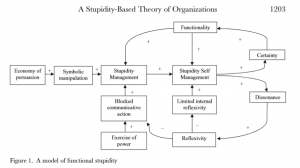TSElosophers meeting on 14.11.2023. Participants: Albrecht Becker, Behnam Pourahmadi, Erkki Lassila, François-René Lherm, Kari Lukka, Mia Salo, Milla Unkila, Minna-Liina Ojala, Otto Rosendahl
Luhmann (2002) I see something you don’t see. In: Luhmann & Rasch (2002) Theories of distinction. Redescribing the descriptions of modernity. pp. 187-193.
Description
We read a conference speech given by Niklas Luhmann that criticized the continuing relevance of Frankfurt School, that is late 20th Century critical theory. We were unable to date the conference speech, but the original German text was published in 1990.
Luhmann focuses his critique on the Frankfurt School’s ontological standpoint, which many other European philosophical and sociological traditions follow, too. The ontological metaphysics of the Frankfurt School, Luhmann argues, i.e. its guiding distinction of existence/non-existence, enforces a bivalent logic that differs from the guiding distinction of system/environment and the paradox embracing logic in Luhmann’s systems theory. In his view, the Frankfurt School includes in their definition of rationality an aim for consensus of knowledge through intersubjectivity. This contrasts with Luhmann’s position, which renounces the object/subject distinction in favor of the cybernetic take on observation in which an observation can always be challenged by observing the observation.
Our discussion
The text was described as dense, and some parts required several readings to become at least reasonably understandable. The conference speech was most likely delivered to a German audience already familiar with both theories, which might explain the very limited contextualization of the text. However, as one of us suggested, other Luhmann’s texts may well be equally, if not even more, difficult to read. Some had given up before finishing the text, but many endured, and the discussion was very lively. His writing style was also strategically appreciated since he presented his own position quite briefly, concentrating on the arguments about the insufficiency of the Frankfurt school.
While some of us had doubts about certain aspects of Luhmann’s argumentation, we did not reject Luhmann’s criticisms of the Frankfurt school. We noted however that it’s out of our scope to discuss to which extent contemporary critical theory can respond to these criticisms. We discussed especially Luhmann’s criticism towards any social theory that emphasizes ‘society as it isn’t’. The Frankfurt School had a knack for creating future utopias and dystopias and criticizing society from those vantage points. Luhmann claims that this strategy is used to mask the inability of the Frankfurt School to ‘sufficiently’ describe our complex ‘society as it is’. Luhmann’s social theory, in contrast, includes the paradox between ‘society as it is’ and (the paradox of) ‘society as it isn’t’.
Perhaps not least because Luhmann’s speech of course could not comprehensively elaborate his theory, many concerns were raised that his theory could offer something worthwhile. Many of us noted some similarities to Latour’s work, as ANT proposes taking a similarish ‘bird’s eye’ view as Luhmann’s suggestion of second order observation: instead of inserting oneself into the discussions between observers, one should focus on mapping the terrain as represented by the diverse observations and interactions. Concerns included, for example, the rejection of the guiding distinction of whole/parts as expressed in such reductionism that results in a focus on cognition and a seeming neglect to materiality; his non-humanism and the somewhat nihilistic attitude that follows from the sought-after distancing of the researcher from the first level observers; doubts about how the self-reflection of the blind spot could improve his theory; that reflection might lead to infinite regression although the text also mentions the emergence of stability with system eigen-values; and that his position remains marginal both in systems theories and philosophy of science.
As a final note, we might ask if Luhmann’s theory is outright conservative or just differently radical. While Luhmann’s lack of an explicitly critical agenda compared to the Frankfurt School felt “disastrous” to several of us, gaining knowledge about ‘society as it is’ and how to relate it with ‘society as it isn’t’ by increasing the complexity of the theoretical framework could support constructive responses to societal problems.
